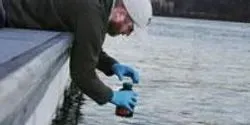environmental science

Scientists have known for years that together, bacteria and plants can remediate contaminated sites. Ramakrishna Wusirika, of Michigan Technological University, has determined that how you add bacteria to the mix can make a big difference.

Buried deep in the mud along the banks of a remote salt lake near Yosemite National Park are colonies of bacteria with an unusual property: they breathe a toxic metal to survive. Researchers from the University of Georgia discovered the bacteria on a recent field expedition to Mono Lake in California, and their experiments with this unusual organism show that it may one day become a useful tool for industry and environmental protection.

Everyone from the Boise, Idaho area is familiar with the scenic Boise River next to the Boise State University campus, but only a few insiders know about a hidden stream located downtown at the intersection of Broadway and Front streets. The artificial stream, called a “flume,” can be found on the ground floor of the Idaho Water Center and is the site of a collaborative research initiative by scientists from Boise State and the University of Idaho (UI). The project is funded by the National Science Foundation (NSF).

Drexel University is opening a new research institute that will strive to answer some of the most challenging questions about energy and environmental sustainability facing the nation today.












